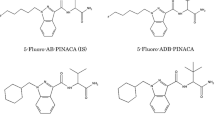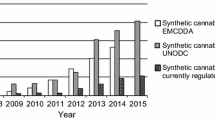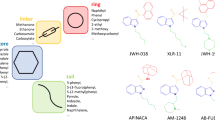Abstract
The most frequent form of consumption of cannabinoid receptor agonists (CRAs), often referred to as synthetic cannabinoids, is smoking of herbal mixtures often obtained via the Internet. However, because the plant material is either sprayed with or soaked in a drug solution, one of the main health risks in using these products is made up by the inhomogeneity in the content of active ingredient(s) and distribution within the mixtures. In the present study, 311 herbal mixtures covering 31 different brands seized from an online retailer in 2012 were analyzed quantitatively by high-performance liquid chromatography with diode array detection after screening by gas chromatography–mass spectrometry. Both interpackage and intrapackage CRA content variation were investigated by sampling without prior homogenization to reflect drug user behavior. The results showed that it is impossible for the consumer to safely dose these drugs, and that two joints of herbal mixture prepared from the same package could contain significantly different amounts of the active substance. Therefore, accidental overdosing is likely to occur frequently. In some products, interpackage variability of up to 33 % [standard deviation (SD)] and intrapackage variability of up to 20 % (SD) were observed. Another major health risk is posed by the substitution of a CRA in a herbal mixture without changing the brand name. In almost all cases when such a substitution was observed, there was a pronounced difference in the binding affinities of the respective CRA without a noticeable change in the amount added to the plant material. These findings can partly explain the high number of unintended intoxications that require hospitalization after use of these drugs.




Similar content being viewed by others
References
Auwärter V, Dresen S, Weinmann W, Müller M, Pütz M, Ferreiros N (2009) ‘Spice’ and other herbal blends: harmless incense or cannabinoid designer drugs? J Mass Spectrom 44:832–837
Uchiyama N, Kikura-Hanajiri R, Kawahara N, Goda Y (2009) Identification of a cannabimimetic indole as a designer drug in a herbal product. Forensic Toxicol 27:61–66
European Monitoring Centre for Drugs and Drug Addiction (2012) The state of the drugs problem in Europe, annual report 2012. Publications Office of the European Union, Lisbon
European Monitoring Centre for Drugs and Drug Addiction (2014) European drug report 2014: trends and developments. Publications Office of the European Union, Lisbon
Langer N, Lindigkeit R, Schiebel HM, Ernst L, Beuerle T (2014) Identification and quantification of synthetic cannabinoids in ‘spice-like’ herbal mixtures: a snapshot of the German situation in the autumn of 2012. Drug Test Anal 6:59–71
Choi H, Heo S, Choe S, Yang W, Park Y, Kim E, Chung H, Lee J (2013) Simultaneous analysis of synthetic cannabinoids in the materials seized during drug trafficking using GC–MS. Anal Bioanal Chem 405:3919–3963
Logan BK, Reinhold LE, Xu A, Diamond FX (2012) Identification of synthetic cannabinoids in herbal incense blends in the United States. J Forensic Sci 57:1168–1180
Shanks KG, Dahn T, Behonick G, Terrell A (2012) Analysis of first and second generation legal highs for synthetic cannabinoids and synthetic stimulants by ultra-performance liquid chromatography and time of flight mass spectrometry. J Anal Toxicol 36:360–371
Kneisel S, Bisel P, Brecht V, Broecker S, Müller M, Auwärter V (2012) Identification of the cannabimimetic AM-1220 and its azepane isomer (N-methylazepan-3-yl)-3-(1-naphthoyl)indole in a research chemical and several herbal mixtures. Forensic Toxicol 30:126–134
Moosmann B, Kneisel S, Girreser U, Brecht V, Westphal F, Auwärter V (2012) Separation and structural characterization of the synthetic cannabinoids JWH-412 and 1-[(5-fluoropentyl)-1H-indol-3yl]-(4-methylnaphthalen-1-yl)methanone using GC–MS, NMR analysis and a flash chromatography system. Forensic Sci Int 220:e17–e22
Moosmann B, Kneisel S, Wohlfarth A, Brecht V, Auwärter V (2013) A fast and inexpensive procedure for the isolation of synthetic cannabinoids from ‘Spice’ products using a flash chromatography system. Anal Bioanal Chem 405:3929–3935
Huppertz LM, Kneisel S, Auwärter V, Kempf J (2014) A comprehensive library-based, automated screening procedure for 46 synthetic cannabinoids in serum employing liquid chromatography-quadrupole ion trap mass spectrometry with high-temperature electrospray ionization. J Mass Spectrom 49:117–127
United Nations Office on Drugs and Crime (2013) Recommended methods for the identification and analysis of synthetic cannabinoid agonists in seized materials. UNODC, Vienna
Cayman Chemical (2014) Cayman Spectral library. Accessible via https://www.caymanchem.com/app/template/SpectralLibrary.vm. Accessed June 2014
Makriyannis A, Deng H (2007) Cannabimimetic indole derivates. A., US Patent No. 7,241,799
Huffman JW, Padgett LW (2005) Recent developments in the medicinal chemistry of cannabimimetic indoles, pyrroles and indenes. Curr Med Chem 12:1395–1411
Frost JM, Dart MJ, Tietje KR, Garrison TR, Grayson GK, Daza AV, El-Kouhen OF, Yao BB, Hsieh GC, Pai M, Zhu CZ, Chandran P, Meyer MD (2009) Indol-3-ylcycloalkyl ketones: effects of N1 substituted indole side chain variations on CB2 cannabinoid receptor activity. J Med Chem 53:295–315
Wiley JL, Marusich JA, Lefever TW, Grabenauer M, Moore KN, Thomas BF (2013) Cannabinoids in disguise: Δ9-tetrahydrocannabinol-like effects of tetramethylcyclopropyl ketone indoles. Neuropharmacology 75:145–154
Huffman JW, Padgett LW, Isherwood ML, Wiley JL, Martin BR (2006) 1-Alkyl-2-aryl-4-(1-naphthoyl)pyrroles: new high affinity ligands for the cannabinoid CB1 and CB2 receptors. Bioorg Med Chem Lett 16:5432–5435
Acknowledgments
The authors thank the Drug Prevention and Information Programme of the European Union (JUST/2011/DPIP/AG/3597), the German Federal Ministry of Health, and the City of Frankfurt/Main for financial support.
Conflict of interest
There are no financial or other relations that could lead to a conflict of interest.
Author information
Authors and Affiliations
Corresponding author
Rights and permissions
About this article
Cite this article
Moosmann, B., Angerer, V. & Auwärter, V. Inhomogeneities in herbal mixtures: a serious risk for consumers. Forensic Toxicol 33, 54–60 (2015). https://doi.org/10.1007/s11419-014-0247-4
Received:
Accepted:
Published:
Issue Date:
DOI: https://doi.org/10.1007/s11419-014-0247-4




